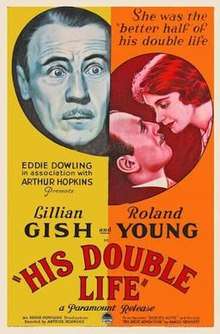His Double Life
| His Double Life | |
|---|---|
 Movie poster | |
| Directed by |
Arthur Hopkins William C. deMille (uncredited) |
| Produced by |
Eddie Dowling Arthur Hopkins |
| Written by |
Clara Beranger Arthur Hopkins |
| Based on |
the novel Buried Alive and the play Great Adventure by Arnold Bennett[1] |
| Starring |
Roland Young Lillian Gish |
| Music by |
James F. Hanley Karl Stark John Rochetti |
| Cinematography | Arthur Edeson |
| Edited by |
Arthur Ellis A. Pam Blumenthal |
Production company |
Eddie Dowling Pictures |
| Distributed by | Paramount Pictures |
Release date |
|
Running time | 68 minutes |
| Country | United States |
| Language | English |
His Double Life is a 1933 American pre-Code comedy-drama film directed by Broadway theatrical impresario and first time film director Arthur Hopkins with directorial input from the experienced William C. deMille, Cecil's older brother. It starred Roland Young and Lillian Gish.
It had been filmed before in 1921 in the silent era as The Great Adventure with Lionel Barrymore, and was remade again in 1943 as Holy Matrimony with Monty Woolley. It is preserved at the Library of Congress, Washington D.C. and is available on DVD.
Plot
Priam Farrel (Roland Young) is England's greatest painter. A recluse who hates fame, he has been away from England and has never even seen his agent. When a woman mistakenly believes he has proposed marriage to her, he and his valet Henry Leek hastily return to England. After Leek dies soon after of pneumonia, the attending doctor mistakes him for Priam and informs the press. The real Priam is glad to be mistaken for his valet by everyone, even his cousin Duncan (who has not seen him since he was 12). After several attempts to clear up the misidentification, he gives up.
He goes to a hotel, where he meets Alice Chalice (Lillian Gish), who was put in touch with Leek through a matrimonial agency and, by chance, was to meet Leek for the first time there. Leek had sent her a photograph of him and Priam together, so she makes the same mistake. Priam finds her very pleasant to be with. He has qualms when he learns that "he" is to be accorded the great honor of being interred in Westminster Abbey, but once again he is unable to convince anyone, including Alice, that he is the painter.
He is happy to marry Alice and live a quiet country life. Then Alice's income from brewery shares disappears, along with the brewery, but Priam assures her that he can provide for her by selling some of his paintings. She is skeptical, however. Nonetheless, she sells some of his paintings, mainly for the frames. One painting passes through several hands and ends up with Oxford, Priam's old agent, who recognizes the artist's style. Oxford buys all of Priam's new paintings and resells them, guaranteeing that that are genuine Farrels.
Oxford tracks Priam down and asks him to reveal he is still alive. It turns out that one of the paintings Oxford sold had a date on it, 1932, two years after Priam's "death", and the buyer has taken Oxford to court. Priam strenuously refuses, so Oxford takes another approach, placing an advertisement asking for information about Henry Leek.
Leek's widow shows up, accompanied by her clergymen sons John and Henry. Her husband deserted her about 25 years before after the birth of their twin sons. She identifies Priam as him. Priam bolts at the first opportunity, but Alice is more than up to the challenge. She portrays her "Henry" as violent and not entirely sane and points out that there would be a scandal. The Leeks hastily depart.
Even so, Priam is brought into court. In the course of testimony, his cousin Duncan recalls that he has two moles on his neck. Priam stubbornly refuses to show them, but Alice convinces him to do so. Afterward, Priam and Alice sail away to recover their privacy.
Cast
- Roland Young as Priam Farrel
- Lillian Gish as Alice Chalice
- Montagu Love as Duncan Farrel
- Lumsden Hare as Oxford
- Lucy Beaumont as Mrs. Leek
- Charles Richman as Witt
- Oliver Smith as Leek Twin - John
- Philip Tonge as Leek Twin - Henry
- Audrey Ridgewell as Lady Helen
- Regina DeValet as Mary
- Charles Halton as Newsman on Phone (uncredited)
- Roland Hogue as Henry Leek (uncredited)
Soundtrack
"Someday, Sometime, Somewhere" and "Springtime in Old Granada", written by James F. Hanley and Karl Stark
References
- ↑ Mordaunt Hall (December 16, 1933). "Roland Young and Lillian Gish in a Picturization of Arnold Bennett's Novel 'Buried Alive.'". The New York Times. (Subscription required (help)).
See also
External links
- His Double Life on IMDb
- synopsis at AllMovie
- His Double Life is available for free download at the Internet Archive